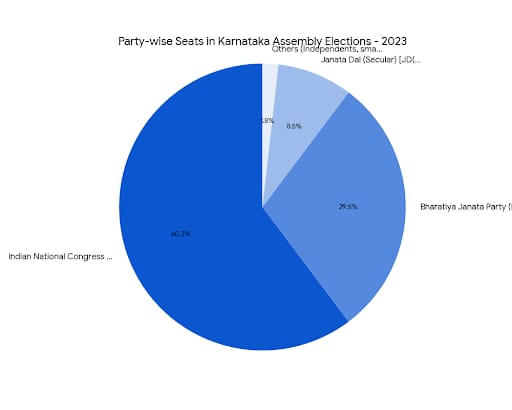Karnataka Assembly Election
1952 Karnataka Legislative Assembly Election Results
| 1952 Karnataka Assembly Election Results | |||
|---|---|---|---|
| Sr. No. | Short Name | Full Name | Seats |
| 1 | INC | Indian National Congress | 74 |
| 2 | (KMPP) | Kisan Mazdoor Praja Party | 8 |
| 3 | Socialist Party | Socialist Party | 4 |
| 4 | SCF | Scheduled Castes Federation | 3 |
| 5 | Independents | Independents | 10 |
| 6 | Others | Others | 0 |
| 7 | Others | Others | 0 |
| Total | 99 | ||
The first ever Assembly election in Mysore State (later Karnataka) was held in 1952 as part of India’s first general elections (1951–52).
The Indian National Congress (INC), led in the state by Kengal Hanumanthaiah, secured a decisive majority with 74 seats.
The Kisan Mazdoor Praja Party (KMPP), formed by J.B. Kripalani after leaving Congress, managed to win 8 seats and became the largest opposition group.
The Socialist Party and Scheduled Castes Federation (SCF) had a limited presence, while independent candidates won 10 seats, showing localized influence.
With this victory, Kengal Hanumanthaiah of the INC became the second Chief Minister of Mysore (after K.C. Reddy, who was nominated CM in 1947).
This election set the foundation for Congress dominance in Karnataka’s politics during the early decades.
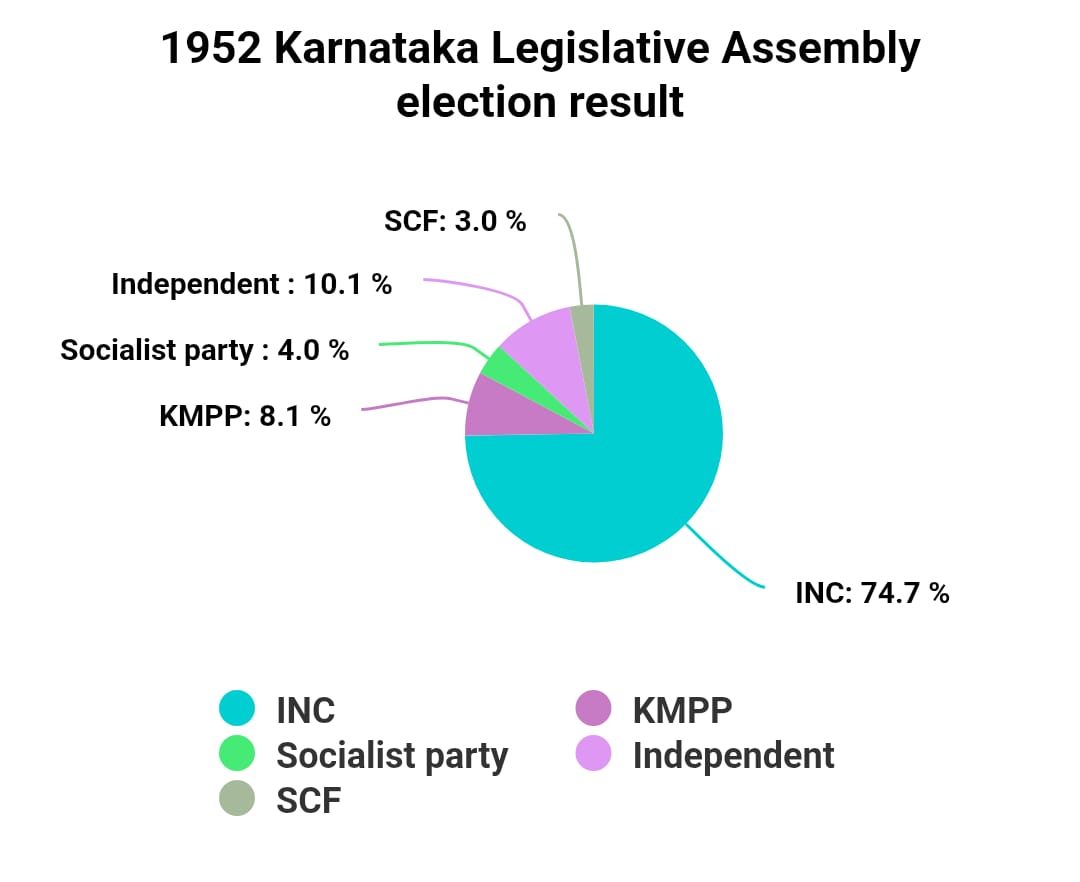
1957 Karnataka Legislative Assembly Election Results
| 1957 Karnataka Assembly Election Results | |||
|---|---|---|---|
| Sr. No. | Short Name | Full Name | Seats |
| 1 | INC | Indian National Congress | 150 |
| 2 | PSP | Praja Socialist Party | 18 |
| 3 | CPI | Communist Party of India | 3 |
| 4 | Independents | Independents | 35 |
| 5 | Others | Others | 2 |
| Total | 208 | ||
This was the first assembly election after the reorganisation of states (1956), when Mysore became a much larger state by including Kannada-speaking areas.
The Indian National Congress continued its dominance, winning 150 out of 208 seats, securing a comfortable majority.
The Praja Socialist Party (PSP), formed in 1952 by merging the Socialist Party and KMPP, emerged as the main opposition with 18 seats.
The Communist Party of India (CPI) had a small presence with 3 seats.
Independents still had significant success with 35 seats, showing the role of local leaders in the newly merged areas.
S. Nijalingappa (INC) became the Chief Minister after this election.
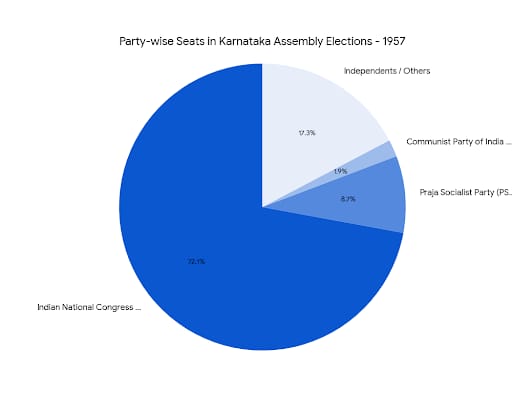
1962 Karnataka Legislative Assembly Election Results
| 1962 Karnataka Legislative Assembly Election Results | |||
|---|---|---|---|
| Sr. No. | Short Name | Full Name | Seats |
| 1 | INC | Indian National Congress | 138 |
| 2 | PSP | Praja Socialist Party | 20 |
| 3 | Swatantra Party | Swatantra Party | 15 |
| 4 | CPI | Communist Party of India | 4 |
| 5 | Independents | Independents | 31 |
| 6 | Others | Others | 0 |
| Total | 208 | ||
The 1962 election was the third assembly election in Mysore and the second after the reorganisation of states.
The Indian National Congress (INC) continued its dominance with 138 seats, though its tally fell compared to 1957 (150 seats).
The Praja Socialist Party (PSP) held its ground with 20 seats, remaining the main opposition.
The Swatantra Party, founded in 1959 by C. Rajagopalachari and others as a pro-market, anti-Congress party, contested for the first time and made a strong entry with 15 seats.
The Communist Party of India (CPI) managed to win 4 seats.
Independents again performed well, winning 31 seats, showing the continued strength of local leaders in certain regions.
After the election, S. Nijalingappa (INC) continued as the Chief Minister.
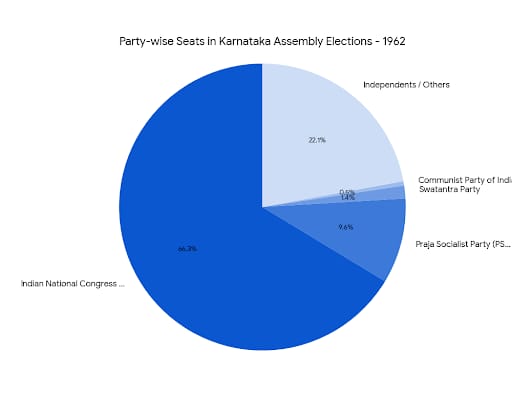
1967 Karnataka Legislative Assembly Election Results
| 1967 Karnataka Legislative Assembly Election Results | |||
|---|---|---|---|
| Sr. No. | Short Name | Full Name | Seats |
| 1 | INC | Indian National Congress | 126 |
| 2 | PSP | Praja Socialist Party | 20 |
| 3 | Swatantra Party | Swatantra Party | 16 |
| 4 | CPI | Communist Party of India | 3 |
| 5 | BJS | Bharatiya Janata Sangh | 4 |
| 6 | Independents | Independents | 47 |
| Total | 216 | ||
The Congress remained in power with 126 seats, but its strength had fallen compared to 1962 (138 seats).
The Praja Socialist Party (PSP) secured 20 seats, continuing as a strong opposition voice.
The Swatantra Party held on with 16 seats, representing conservative, pro-market voters.
The Bharatiya Jana Sangh (BJS) (precursor to BJP) entered the Assembly with 4 seats, its early footprint in Karnataka.
The Communist Party of India (CPI) won 3 seats.
Independents had a major role, winning 47 seats, showing the popularity of local leaders and fragmented opposition.
S. Nijalingappa (INC) became Chief Minister again after this election.
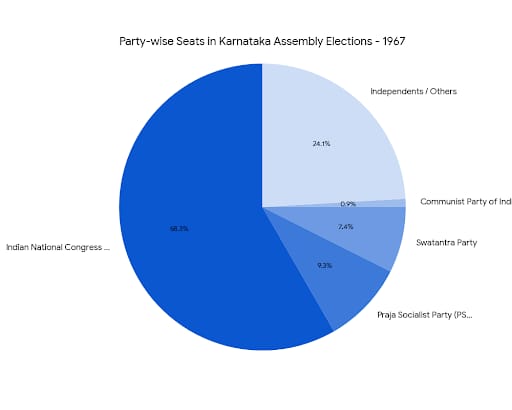
1972 Karnataka Legislative Assembly Election Results
| 1972 Karnataka Legislative Assembly Election Results | |||
|---|---|---|---|
| Sr. No. | Short Name | Full Name | Seats |
| 1 | INC | Indian National Congress | 165 |
| 2 | INC | Indian National Congress | 24 |
| 3 | PSP | Praja Socialist Party | 3 |
| 4 | SSP | Samyukta Socialist Party | 2 |
| 5 | CPI | Communist Party of India | 2 |
| 6 | BJS | Bharatiya Jana Sangh | 2 |
| 7 | Independents | Independents | 18 |
| Total | 216 | ||
The 1972 election was held during a time when the Congress had split (1969) into two factions: Congress (Indira) [INC] led by Indira Gandhi, and Congress (Organisation) [INC(O)] led by K. Kamaraj and others.
In Mysore (later renamed Karnataka in 1973), the Indira-led Congress (INC) scored a massive victory with 165 seats, one of its best performances in the state.
The Congress (Organisation) managed only 24 seats, becoming a weak opposition.
Smaller socialist parties like PSP (3 seats) and SSP (2 seats) were almost wiped out.
Bharatiya Jana Sangh (BJS) and CPI won just 2 seats each, showing limited influence.
Independents captured 18 seats, still reflecting local leader strength but in reduced numbers compared to previous elections.
After the election, Devaraj Urs (INC – Indira faction) became the Chief Minister, known for his progressive and pro-backward classes policies.
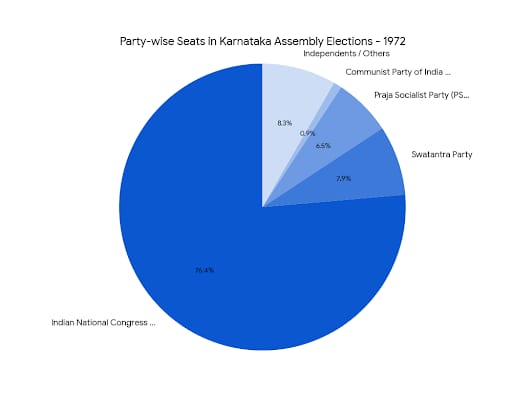
1978 Karnataka Legislative Assembly Election Results
| 1978 Karnataka Legislative Assembly Election Results | |||
|---|---|---|---|
| Sr. No. | Short Name | Full Name | Seats |
| 1 | INC | Indian National Congress | 149 |
| 2 | Janata Party | Janata Party | 59 |
| 3 | INC | Indian National Congress | 2 |
| 4 | CPI | Communist Party of India | 3 |
| 5 | (Marxist) – CPI(M) | Communist Party of India | 1 |
| 6 | Independents | Independents | 10 |
| Total | 224 | ||
This was the first Assembly election after the Emergency (1975–77) and after the state was officially renamed Karnataka (1973).
The Indian National Congress (Indira) [INC(I)], led by D. Devaraj Urs, won a landslide with 149 seats, retaining power.
The newly formed Janata Party (an alliance of Congress(O), Bharatiya Jana Sangh, Socialists, and others) secured 59 seats, emerging as the main opposition.
The old Congress (Organisation) faction was almost extinct, winning only 2 seats.
Left parties had a very small presence — CPI (3 seats) and CPI(M) (1 seat).
Independents managed 10 seats, a decline compared to earlier decades.
Devaraj Urs continued as Chief Minister, carrying forward his social justice and land reform agenda.
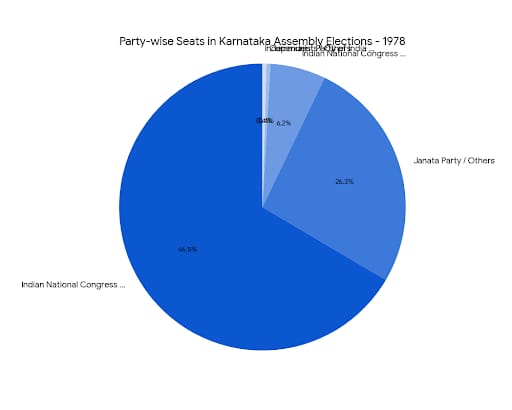
1983 Karnataka Legislative Assembly Election Results
| 1983 Karnataka Legislative Assembly Election Results | |||
|---|---|---|---|
| Sr. No. | Short Name | Full Name | Seats |
| 1 | INC | Indian National Congress | 82 |
| 2 | Janata Party | Janata Party | 95 |
| 3 | BJP | Bharatiya Janata Party | 18 |
| 4 | CPI | Communist Party of India | 3 |
| 5 | (Marxist) – CPI(M) | Communist Party of India | 3 |
| 6 | Independents | Independents | 22 |
| 7 | Others | Others | 1 |
| Total | 224 | ||
The 1983 election was a watershed moment in Karnataka politics. For the first time, the Congress lost its grip on the state.
The Janata Party emerged as the single largest party with 95 seats, though it fell short of the majority (113).
The Congress managed only 82 seats, its worst performance in the state until then.
The BJP, still a small force nationally, made a breakthrough in Karnataka by winning 18 seats, laying the foundation for its future rise.
Left parties — CPI (3) and CPI(M) (3) — retained a small but visible presence.
Independents (22) played a decisive role in government formation.
With support from the BJP and independents, Ramakrishna Hegde (Janata Party) became the first non-Congress Chief Minister of Karnataka.

1985 Karnataka Legislative Assembly Election Results
| 1985 Karnataka Legislative Assembly Election Results | |||
|---|---|---|---|
| Sr. No. | Short Name | Full Name | Seats |
| 1 | Janata Party | Janata Party | 139 |
| 2 | INC | Indian National Congress | 65 |
| 3 | BJP | Bharatiya Janata Party | 2 |
| 4 | CPI | Communist Party of India | 3 |
| 5 | (Marxist) – CPI(M) | Communist Party of India | 3 |
| 6 | Independents | Independents | 12 |
| Total | 224 | ||
The 1985 election was held just two years after the historic 1983 polls in which the Congress had lost power.
The Janata Party, led by Ramakrishna Hegde, secured a clear and comfortable majority with 139 seats, strengthening its position in Karnataka politics.
The Congress managed only 65 seats, showing that its decline in the state continued.
The BJP, which had won 18 seats in 1983, dropped sharply to just 2 seats, indicating a temporary setback.
The Left parties, CPI (3) and CPI(M) (3), maintained a small but steady presence.
Independents secured 12 seats, continuing their traditional role in Karnataka politics.
Ramakrishna Hegde (Janata Party) became Chief Minister again, this time with a stronger mandate, and continued his reforms in decentralization and transparency.
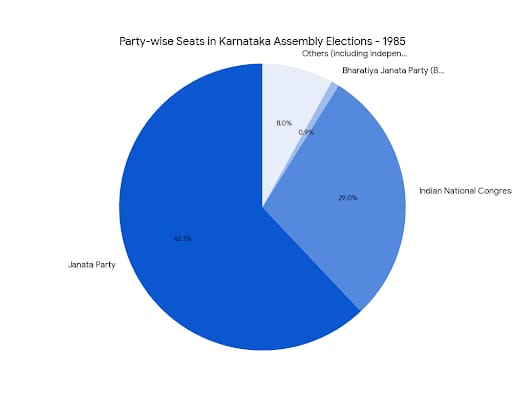
1989 Karnataka Legislative Assembly Election Results
| 1989 Karnataka Legislative Assembly Election Results | |||
|---|---|---|---|
| Sr. No. | Short Name | Full Name | Seats |
| 1 | Janata Party | Janata Party | 178 |
| 2 | Janata Dal | Janata Dal | 24 |
| 3 | BJP | Bharatiya Janata Party | 4 |
| 4 | CPI | Communist Party of India | 3 |
| 5 | (Marxist) – CPI(M) | Communist Party of India | 2 |
| 6 | Independents | Independents | 13 |
| Total | 224 | ||
The 1989 election marked a resurgence of the Congress Party in Karnataka.
Riding on anti-incumbency against the Janata Party government and divisions within opposition ranks, the Congress swept the polls with 178 seats, one of its best performances ever in the state.
The Janata Party had split into the Janata Dal and other smaller factions by this time; the Janata Dal managed only 24 seats.
The BJP won just 4 seats, still struggling to expand beyond its small base.
Left parties (CPI – 3 seats, CPI(M) – 2 seats) maintained marginal representation.
Independents got 13 seats, but their influence had declined compared to earlier decades.
Veerendra Patil (INC) became the Chief Minister after this victory, marking his return to the top post (he had briefly served as CM in the late 1960s).
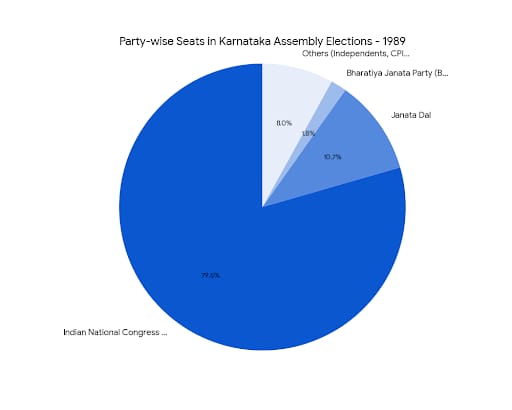
1994 Karnataka Legislative Assembly Election Results
| 1994 Karnataka Legislative Assembly Election Results | |||
|---|---|---|---|
| Sr. No. | Short Name | Full Name | Seats |
| 1 | Janata Dal | Janata Party | 115 |
| 2 | INC | Indian National Congress | 34 |
| 3 | BJP | Bharatiya Janata Party | 40 |
| 4 | (KRRS) / Others | Karnataka Rajya Ryota Sangha | 2 |
| 5 | Independents | Independents | 33 |
| Total | 224 | ||
The 1994 election marked a major comeback for the Janata Dal, which won 115 seats, securing a majority on its own.
The Congress suffered one of its worst defeats in Karnataka, winning only 34 seats, largely due to anti-incumbency and internal factionalism.
The BJP emerged as a serious player for the first time, winning 40 seats and establishing itself as a strong opposition force in the state.
Independents continued to have a significant role, securing 33 seats.
H.D. Deve Gowda (Janata Dal) became the Chief Minister after this election. He later went on to become the Prime Minister of India in 1996, after which J.H. Patel succeeded him as Karnataka’s CM.
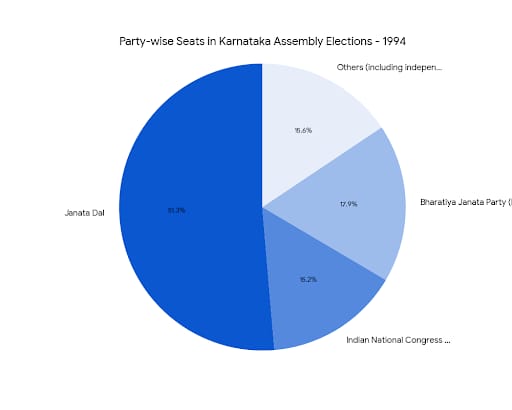
1999 Karnataka Legislative Assembly Election Results
| 1999 Karnataka Legislative Assembly Election Results | |||
|---|---|---|---|
| Sr. No. | Short Name | Full Name | Seats |
| 1 | INC | Indian National Congress | 132 |
| 2 | JD | Janata Dal | 10 |
| 3 | JD | Janata Dal | 18 |
| 4 | BJP | Bharatiya Janata Party | 44 |
| 5 | Others | Others | 2 |
| 6 | Independents | Independents | 18 |
| Total | 224 | ||
The 1999 election marked the return of Congress to power in Karnataka after its humiliating defeat in 1994.
The Congress won 132 seats, securing a clear majority.
S.M. Krishna (INC) became the Chief Minister, known for his urban development and IT-friendly policies that boosted Bengaluru’s global profile.
The Janata Dal had split into two factions: JD(S) under H.D. Deve Gowda and JD(U) under J.H. Patel. Their division hurt their overall strength — JD(S) won 10 seats and JD(U) won 18 seats.
The BJP improved its tally to 44 seats, consolidating its position as a major opposition force in the state.
Independents (18) and a few smaller groups held some influence, but the election was largely a Congress vs. BJP/Janata factions battle.
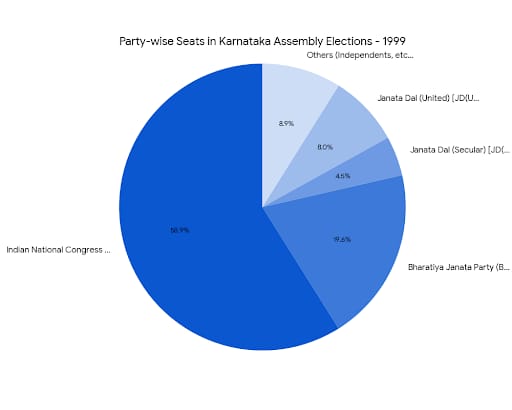
2004 Karnataka Legislative Assembly Election Results
| 2004 Karnataka Legislative Assembly Election Results | |||
|---|---|---|---|
| Sr. No. | Short Name | Full Name | Seats |
| 1 | INC | Indian National Congress | 65 |
| 2 | BJP | Bharatiya Janata Party | 79 |
| 3 | Janata Dal | Janata Dal | 58 |
| 4 | Others | Others | 5 |
| 5 | Independents | Independents | 17 |
| Total | 224 | ||
The 2004 election produced a hung assembly, with no party securing a majority.
The BJP emerged as the single largest party with 79 seats, but it fell short of the majority mark (113).
The Congress, which had ruled under S.M. Krishna, suffered a major setback, dropping to 65 seats.
The JD(S), led by H.D. Deve Gowda and H.D. Kumaraswamy, performed strongly with 58 seats, making it the kingmaker.
Independents (17) and smaller parties (5) held the balance of power.
A Congress–JD(S) coalition government was initially formed with Dharam Singh (INC) as Chief Minister.
In 2006, however, JD(S) broke away from Congress and aligned with the BJP. H.D. Kumaraswamy (JD(S)) became CM with BJP’s support in a power-sharing arrangement.
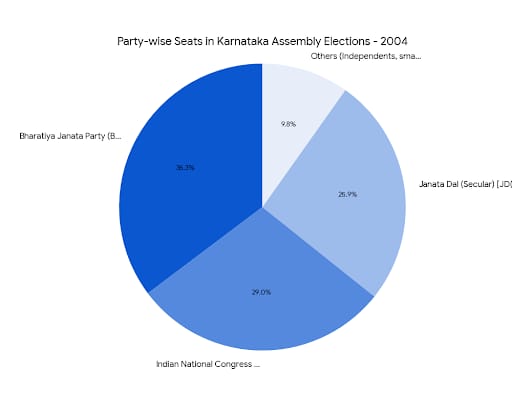
2008 Karnataka Legislative Assembly Election Results
| 2008 Karnataka Legislative Assembly Election Results | |||
|---|---|---|---|
| Sr. No. | Short Name | Full Name | Seats |
| 1 | BJP | Bharatiya Janata Party | 110 |
| 2 | INC | Indian National Congress | 80 |
| 3 | JD | Janata Dal | 28 |
| 4 | BSP | Bahujan Samaj Party | 1 |
| 5 | KJP | Karnataka Janata Paksha | 0 |
| 6 | Independents / Others | Independents / Others | 5 |
| Total | 224 | ||
The 2008 election was a watershed moment in Karnataka politics.
The BJP won 110 seats, just 3 short of the majority, but managed to form the government with support from independents.
The Congress secured 80 seats, continuing its decline in the state.
The JD(S), after its controversial alliance-breaking behavior in 2006, suffered electorally and dropped to 28 seats.
Independents and smaller groups won 5 seats.
B.S. Yediyurappa (BJP) became the first BJP Chief Minister in South India.
This victory was significant because Karnataka became the gateway for BJP in the south, something it had not achieved in states like Tamil Nadu, Kerala, or Andhra Pradesh.
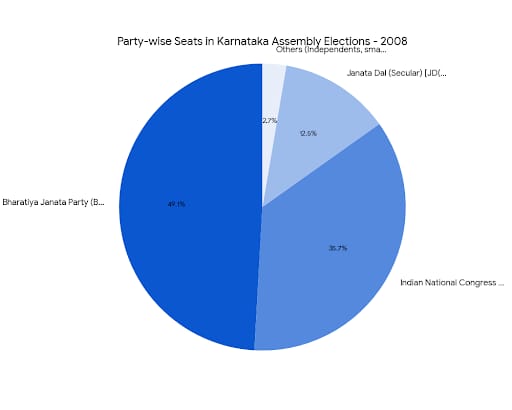
2013 Karnataka Legislative Assembly Election Results
| 2013 Karnataka Legislative Assembly Election Results | |||
|---|---|---|---|
| Sr. No. | Short Name | Full Name | Seats |
| 1 | INC | Indian National Congress | 122 |
| 2 | BJP | Bharatiya Janata Party | 40 |
| 3 | JD | Janata Dal | 40 |
| 4 | KJP | Karnataka Janata Paksha | 6 |
| 5 | (BSR Congress) – B. Sriramulu | Badavara Shramikara Raitara Congress | 4 |
| 6 | Others / Independents | Others / Independents | 12 |
| Total | 224 | ||
The Congress won 122 seats, crossing the majority mark comfortably, and formed the government.
Siddaramaiah (INC) became Chief Minister, leading a stable Congress government from 2013 to 2018.
The BJP suffered a major blow, dropping to 40 seats, due to internal divisions.
B.S. Yediyurappa, who had led BJP to power in 2008, broke away and formed the Karnataka Janata Paksha (KJP), which won 6 seats.
B. Sriramulu, a mining baron, formed the BSR Congress, which bagged 4 seats.
The split in BJP’s vote bank (especially Lingayat support base) directly benefited the Congress.
The JD(S) also won 40 seats, retaining its stronghold in Old Mysuru region.
Independents and smaller parties got 12 seats.
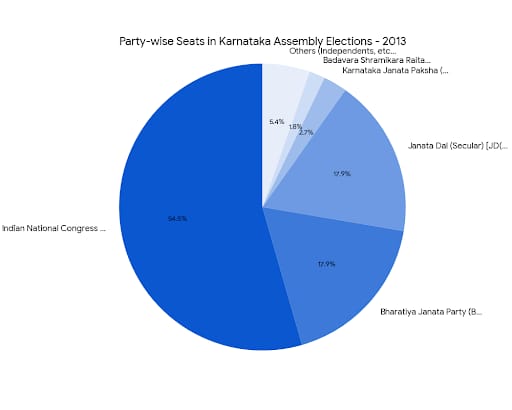
2018 Karnataka Legislative Assembly Election Results
| 2018 Karnataka Legislative Assembly Election Results | |||
|---|---|---|---|
| Sr. No. | Short Name | Full Name | Seats |
| 1 | BJP | Bharatiya Janata Party | 104 |
| 2 | INC | Indian National Congress | 80 |
| 3 | JD | Janata Dal | 37 |
| 4 | BSP | Bahujan Samaj Party | 1 |
| 5 | Independents | Independents | 2 |
| Total | 224 | ||
The BJP emerged as the single largest party with 104 seats, but it was short of the majority (113).
The Congress suffered a setback, winning 80 seats (down from 122 in 2013).
The JD(S), led by H.D. Kumaraswamy, won 37 seats.
Soon after results, the Congress and JD(S) struck a post-poll alliance, with support from BSP (1 seat) and independents.
Together, the Congress + JD(S) alliance had around 118 MLAs, crossing the majority mark.
Governor invited B.S. Yediyurappa (BJP), as the single largest party, to form the government first. He was sworn in as CM but resigned within 3 days after failing to prove majority.
Later, H.D. Kumaraswamy (JD(S)) became CM, with support from Congress.
This coalition was uneasy, with frequent tensions between Congress and JD(S) leaders.
In 2019, mass defections of Congress and JD(S) MLAs led to the fall of the government, and BJP returned to power under B.S. Yediyurappa.
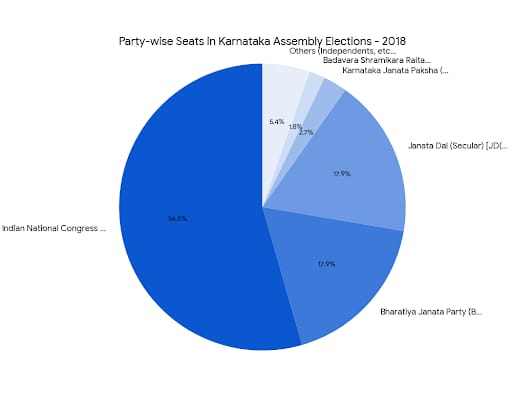
2023 Karnataka Legislative Assembly Election Results
| 2023 Karnataka Legislative Assembly Election Results | |||
|---|---|---|---|
| Sr. No. | Short Name | Full Name | Seats |
| 1 | INC | Indian National Congress | 135 |
| 2 | BJP | Bharatiya Janata Party | 66 |
| 3 | JD | Janata Dal | 19 |
| 4 | KRPP | Kalyana Rajya Pragathi Paksha | 1 |
| 5 | Independents | Independents | 2 |
| 6 | Others | Others | 1 |
| Total | 224 | ||
The Congress secured a sweeping victory with 135 seats, well above the majority mark, and formed a stable government.
The BJP was reduced to 66 seats, its worst performance in Karnataka since 2013.
The JD(S) further declined to 19 seats, showing loss of influence even in its strongholds of Old Mysuru.
The newly formed KRPP (by mining baron G. Janardhana Reddy) won 1 seat.
Independents won 2 seats, while others accounted for 1.
Siddaramaiah (INC) was sworn in again as Chief Minister, and D.K. Shivakumar became Deputy CM.
